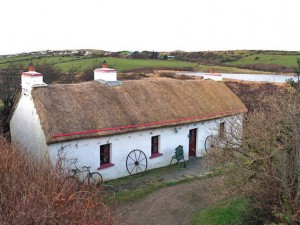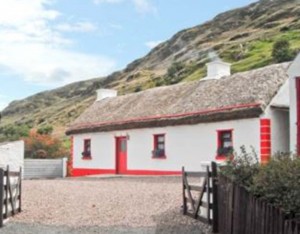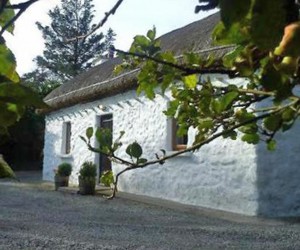Irish Thatched Cottages, and Abandoned Farms
Una McKee writes from Maghera View, Loughros Point:
Some time back on the RTE News and Nation program, stories were gathered together of Ireland that was. One series was on the Thatched Cottages, and their life-style of early days, and even up to the nineteen forties and fifties. This was of interest to me, as this piece of Irish history might put a background picture on the whole story of Ireland.

I should say here that there are about half a dozen thatched cottages still in existence here in Loughros Point. Some of these have been remodelled for tourist vacations (pictures). Others are not lived in but with some thatch on the roof… just for show… and giving you a look into the past. Many old cottages still stand with just the shell of the walls left. You would notice them everywhere, as you travelled around Donegal – and of course other counties in Ireland.
I suppose that’s what sells Ireland… its past… because we do have a very interesting History… but a sad one, and let us learn from it, and not live in it…
Apparently, the life and times of the Thatched Cottages that were the hallmark of Irish Life was all too fast in disappearing from the scene that sold Ireland for tranquility and simplicity. Also one would see a mini type small shed, outside the thatched cottage to keep sticks and some turf, but it is also covered in thatch… which is just a little unusual. The walls would be of slated stone, put together usually by a stonemason – and then a roof of either thatch or tin. But these cottages and sheds did stand the test of time.
What a picturesque cottage! What a picturesque village! They formed an attractive scene which was shown on RTE Nationwide some time back. The presenter, Michael Ryan, began by showing a row of quaint, beautifully restored, thatched cottages, at the end of a town near Waterford and Wexford border. These cottages originally had thatched roofs – and with time some of these cottages were sold, and renovated, by folk who had happy childhood memories of such cottages/houses/homes. They were renovated inside completely – keeping the fireplace as a feature, but putting in the mods and cons, bathroom shower unit, etc. The central area like a country kitchen…. the sink fitted right at the window, with presses/counters continuing each side of the sink and around the kitchen wall, the table and chairs in the centre floor, and some chairs around the fireside area, the little rooms off the main room was also done up and fitted. The door to the cottage was redone and remade as a half door – updated – big mock hinges displayed !
The Thatch was also redone in a modern way approach by a proper Thatcher – but with a proper roof underneath the Thatch – i.e., trimmer laths, proper felt, and then the Thatch on top, not completely mock– but perhaps is more secure, and would last longer and withstand the wind and winter storms that come.
The current Thatcher Man was interviewed, and he has been a proper Thatcher for many years now, and is kept busy with re-thatching roofs in a lot of areas. He explained that there is a fast course for doing Thatching and at present there are 12 people in training for to do thatching as a skill. This man gave some history about what thatching really does… In the past, as in todays Thatching keeps cottages warm in the winter, cool in the summer. It is also used on smaller stone like “Barns” as a covering for fuel for the fire – (wood/sticks etc.) and it was also used on larger barns way back in time for cattle and Hay sheds, keeping things dry, especially turf, which is often covered by a layer of thatch in the open field and kept unbelievably dry. It then showed the Thatcher Man working on one of the cottages, very skillfully.
Michael Ryan then moved on to another one of these long lines of terraced cottages, (all thatched) and spoke to another person, who also restored the cottage that belonged to some former relative. It showed it beautifully done, with a full-door with large mock hinges on the front of the door, beautifully painted a lovely short flower garden, saying that these wonderfully restored row of thatched cottages retain their charm, of Country life and Living that were the hallmark of Irish Life and Times in Ireland – its Past, Present and Future – showing its character, charm and culture – that should not be forgotten!

Remember, the thatcher man said, I am referring to only to 50 to 60 years ago – the 20th Century. The people could just not continue, so just had to leave, hoping to return some day – but many never did! The thatcher man added to his story… he said that in earlier times (say the nineteen forties and fifties and possibly the sixties) men, including himself, went around the various counties on a bike looking for work in the line of thatching… and spent hours travelling on bikes to get that work. This was the stark reality of it all in those days!
This story came to the attention of Michael Ryan of RTE Nationwide by a youngish man, whose lifework was taking photographs of areas from many parts of Ireland, for survey maps , etc. – possibly for the Government – because of an ever changing Ireland, which would need to move with these times and changes. He noticed that there was fewer and fewer cottages left in many rural places that spoke of Ireland and of its past. Its past being forgotten by the growth of urban sprawl, and desolate small farmland dwellings overgrown with the moss of neglect and time showing derelict hollow shells of former cottages, in scenic settings that once had light and life within its walls.
The RTE Nationwide Program gave this young photographer a time slot about the information on the rising amount of cottages and homes just left abandoned in the nineteen forties and fifties- showing his concern about the thatched cottages of Ireland disappearing. They showed some pictures – very sad pictures really – that he took, as he found things, showing a very forlorn cottage, with paint and paper peeling from the walls, a near broken range, with traces of ashes still showing and a huge old pram. From cottage to cottage it showed the traces of life and families and things that once were there. A blackened disused fireplace, with dust and rubble all round, because of the ceiling falling; items like statues, a sewing machine, pictures, clocks, vases and things on shelf, like a round tin caddie and cups and mugs; lamps, table and chairs in the middle of the room, full of rubble and dust and dirt from a falling ceiling, and some old chairs beside the fire-side, just full of dust and dirt, and a place of old side furniture. It was all as if people just got up and left – just could not continue! He felt that this side of Irish Life for the people of the early forties and fifties should not be forgotten.
Remember, said the Photographer, I am referring to only 50 to 6O years ago — the 20th Century! The people just could not continue, so just had to leave. They hoped to return some day – but as we know – many never did! He showed his concern by taking these photos of the Homes and Cottages left abandoned around Ireland and of what he saw… He catalogued them, and had them enlarged and mounted and framed for exhibition in the BRAY Arts Centre, county Wicklow, which was on display last year.
This young photographer had such a concern and vision about it all … that he did something about it!! This photographer continued his searching by locating isolated farm house and taking photographs of their present state. Then he did some research into its former use and position – looking up maps and old photos of the areas – learning how these people lived and worked.
It was noted that people back then, and earlier, only traveled at best 2 to 3 miles away from their homes (history tells us that) and later people used pony and trap in rural areas, and also some rode on horseback. He noted also that turf Kreels were used back then with hooks to hang the Kreels still visible. He noticed also the way the sheds were placed in the different areas and farm places, to keep everything dry within their walls, including livestock for the winter months… Because of his own observation skills, he noticed the way these were all placed and engineered to keep everything dry. There was even a sunken part in the barn area where different grain was stored, and covered in such a way to keep rats and mice away from eating the crop of the season.. A turf shed beside the large long barn for fuel with the possibility of logs and wood included. This is where the turf Kreels were hung up on the walls as well. Because of his own skills, he noticed the way these barns were placed and engineered, for shelter in the winter yet cool in the summer.
In some of these special type barns, they had steps placed on the outside of the barns; these steps then gave entrance to the Hay Loft from the outside and the hay could be lowered to the ground floor to feed cattle or sheep. He continued to take note and sketches so that he could catalogue his findings in order to keep a window open on the Past… He was amazed at this type of “farm” and thought that these folk of early years were very skilled in many areas in making and doing of things. Today, It is established that these type of Barns with the steps on the outside – long or small buildings – are actually listed as part of the Irish Heritage. In other words, they are not to be knocked down … ever …. No.

They are part of our Irish History and because of their unique design and usefulness and rarity, people are asked to preserve them. They have stood the test of time!
On a personal note – when I was a young teenager, working in Dublin, in 1952-53, we would ride our bikes in the evening times to Dun Laoghaire, which was about 9 miles away (18 miles return) to wave goodbye to the many that got onto the sailing boat to England, and a new way of life hopefully. It was always packed and at times it was said that the people were just hanging out of the boat. This was something we lived with from day to day -Will I be next for the Boat? Many of my teenage friends back then did go to England, and never returned… they made a life for themselves in England.
It is good to look forward and make room for the changes, but keeping a window open on the past, reminding us of where we came from. Every picture tells a story! This information on Irish Cottages and Barns made me recall some of the stories from through the years. I hope the story here helps our memories of the life and times of the people who lived in the Irish Cottages.
Una McKee, Maghera View, Loughros Point.
